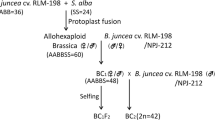Summary
An extensive crossing program including 10 wild taxa and 23 accessions representing 6 major cultivated forms and landraces of theBrassica oleracea group was carried out. Data for crossability, germination, viability, fertility inF 1 andF 2 were studied as well as the meiotic chromosomal pairing inF 1 hybrids in some combinations. The fertility of hybrids between all cultivated forms and wild populations ofB. oleracea was high and it was concluded that all, including the Chinese endemicalboglabra form, belong to the same biological species. Among the other species,B. macrocarpa, B. montana, andB. rupestris had the lowest andB. cretica the highest fertility values in crosses with cultivated forms. The crossing data do not give any further information as to the genetic differentiation ofB. oleracea during the course of domestication. Introgression between wild and cultivated forms has probably occurred frequently. All members of theB. oleracea cytodeme belong to the primary and secondary gene pools of the 18 chromosomic crops and are as such of great importance for breeding purposes.
Similar content being viewed by others
References
Atria, T. & G. Röbbelen, 1986. Cytogenetic relationship within cultivatedBrassica analyzed in amphihaploids from the three diploid ancestors. Can. J. Genet. Cytol. 28: 323–329.
Bailey, L.H., 1922. The cultivated brassicas. Gentes Herbarium I/2: 53–108.
Dias, J.S., M.B. Lima, K.M. Song, A.A. Monteiro, P.H. Williams & T.C. Osborn, 1992. Molecular taxonomy of Portugesetronchuda cabbage and kale landraces using nuclear RFLPs. Euphytica 58: 221–229.
Dias, J.S., A.A. Monteiro & M.B. Lima, 1993. Numerical taxonomy of Portugese Tronchuda cabbage and Galega kale landraces using morphological characters. Euphytica 69: 51–68.
Gray, A.R., 1982. Taxonomy and evolution of Broccoli (Brassica oleracea var.italica). Econ. Bot. 36: 397–410.
Gustafsson, M., 1973. Evolutionary trends in theAtriplex triangularis group. I. Hybrid sterility and chromosomal differentiation. Bot. Notiser 126: 345–392.
Gustafsson, M., 1982. Germplasm conservation of wild (n = 9) MediterraneanBrassica species. J. Swed. Seed Assoc. 92: 133–142.
Gustafsson, M., B. Bentzer, R. von Bothmer & S. Snogerup, 1976. Meiosis in GreenBrassicas of theoleracea group. -Bot. Notiser 129: 73–84.
Gustafsson, M., C. Gómez-Campo & A. Zamanis, 1983. Report from the firstBrassica germplasm exploration in Greece 1982. J. Swed. Seed Assoc. 93: 151–160.
Gustafsson, M., C. Gómez-Campo & A. Zamanis, 1985. Germplasm conservation of wild MediterraneanBrassica species. Collecting missions in 1983. J. Swed. Seed Assoc. 95: 137–143.
Harberd, D.J., 1972. A contribution to the cyto-taxonomy ofBrassica (Cruciferae) and its allies. Bot. J. Linn. Soc. 65: 1–23.
Hosaka, K., S.F. Kianian, J.M. McGrath & C.F. Quiros, 1990. Development and chromosomal localization of genome-specific DNA markers ofBrassica and the evolution of amphiploids andn = 9 diploid species. Genome 33: 131–142.
Inomata, N., 1990. Interspecific hybridization inBrassica through ovary culture. In: Y.P.S. Bajaj (Ed.), Biotechnology in agriculture and forestry, vol. 10. Legumes and oilseed crops I, pp. 367–384. Springer-Verlag, Berlin.
Inomata, N., 1993. Crossability and cytology of hybrid progenies in the cross betweenBrassica campestris and three wild relatives ofB. oleracea, B. bourgeaui, B. cretica andB. montana. Euphytica 69: 7–17.
Kinanian, S.F. & C.F. Quiros, 1992a. Trait inheritance, fertility, and genomic relationships of somen = 9 Brassica species. Genet. Res. Crop Evol. 39: 165–175.
Kinanian, S.F. & C.F. Quiros, 1992b. Generation of aBrassica oleracea composite RFLP linkage map: linkage arrangements among various populations and evolutionary implications. Theor. Appl. Genet. 84: 544–554.
Kristofferson, K.B. 1924. Contributions to the genetics ofBrassica oleracea. Hereditas 5: 297–364.
Kristofferson, K.B. 1927. Contributions to the genetics ofBrassica oleracea, II. Hereditas 9: 343–348.
Mattsson, B., 1988. Artkorsningar inom Brassica och några närstående släkten. J. Swed. Seed Assoc. 98: 187–212.
Oost, E.H., W.A. Brandenburg & C.E. Jarvis, 1989. Typification ofBrassica oleracea L. and its Linnean varieties. Bot. J. Linn. Soc. 101:329–345.
Perrino, P. & K. Hammer, 1985. Collection of landraces of cultivated plants in South Italy 1984. Kulturptlanze 33: 225–236.
Snogerup, S., 1980. The wild forms of theBrassica oleracea group (2n = 18) and their possible relations to the cultivated ones. In: S. Tsunoda, K. Hinata & C. Gómez-Campo (Eds.),Brassica crops and wild allies, pp. 121–132. Jpn. Sci. Soc. Press, Tokyo.
Snogerup, S., 1993. Cytogenetic differentiation and reproduction inBrassica sect.Brassica. In: H. Demiriz, (Ed.), Proceed. 5th Optima Meeting, Istanbul, 8–15 Sept. 1986. Istanbul, pp. 377–393.
Snogerup, S., M. Gustafsson & R. von Bothmer, 1990.Brassica sect.Brassica (Brassicaceae). I. Taxonomy and variation. -Willdenowia 19: 271–365.
Song, K., T.C. Osborn & P.H. Williams, 1990.Brassica taxonomy based on nuclear restriction fragment length polymorphisms. (RFLPs): 3. Genome relationships inBrassica and related genera and the origin ofB. oleracea andB. rapa (syn.campestris). -Theor. Appl. Genet. 79: 497–506.
Vaughan, J.G., A.J. MacLeod & B.M.G. Jones (Eds.), 1976. The biology and chemistry of the Cruciferae. Academic Press, London.
Warwick, S.I. & L.D. Black, 1991. Molecular systematics ofBrassica and allied genera (subtribeBrassicinae, Brassiceae) — chloroplast genome and cytodeme congruence. Theor. Appl. Genet. 82: 81–92.
Author information
Authors and Affiliations
Rights and permissions
About this article
Cite this article
von Bothmer, R., Gustafsson, M. & Snogerup, S. Brassica sect.Brassica (Brassicaceae). Genet Resour Crop Evol 42, 165–178 (1995). https://doi.org/10.1007/BF02539520
Received:
Accepted:
Issue Date:
DOI: https://doi.org/10.1007/BF02539520




